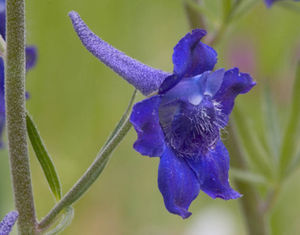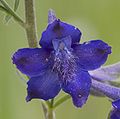Delphinium nuttallii
- Latin Name: Delphinium nuttallii
- Family: Ranunculaceae
- Common Names: Nuttall's larkspur
- Codon: DELNUT
Contents
Taxonomy
| Delphinium nuttallii | |
|---|---|

| |
| Photo by Rod Gilbert, 2004. Also featured on Main Page. | |
| Scientific classification | |
| Kingdom: | Plantae |
| Subkingdom: | Viridiplantae |
| Phylum: | Tracheophyta |
| Subphylum: | Spermatophytina |
| Class: | Magnoliopsida |
| Subclass: | Ranunculanae |
| Order: | Ranunculales |
| Family: | Ranunculaceae |
| Genus: | Delphinium L. |
| Species: | Delphinium nuttallii A. Gray |
| Synonyms | |
| |
Description
General: Crisp-puberulent, eglandular perennial from small, globose, fleshy roots, the single stems 3-6 dm. tall.
Leaves: Leaves long-petiolate, evenly distributed, the blades up to 10 cm. broad, 3-4 times dissected into narrowly lanceolate or linear segments.
Flowers: Inflorescence simple to compound, the racemes spike-like above, the lower pedicels exceeding the numerous, crowded flowers; sepals 5, deep bluish-purple, 7-12 mm. long, slightly spreading, with a conspicuous median, pubescent, greenish band; spur equal to the sepals; petals 4, small, the lower pair deep purplish-blue, shallowly cleft, the upper pair light blue; stamens numerous; pistils 3.
Fruit: Follicles about 15 mm. long, slightly bent.
Bloom Period
May through June.
Distribution
Pierce and eastern Grays Harbor Counties, Washington, south to the Columbia River Gorge and Clackamas County, Oregon.
Habitat
Ecological Setting-Gravelly outwash prairies and basaltic cliffs.
Uses
Landscaping-Not very easy to grow, but looks like it will reseed itself.
Propagation
Extended cold, moist stratification is needed. Cool spring temperatures may also be necessary. In trials at the Pullman PMC, no germination occurred without stratification and no seed germinated after 30 days cold, moist stratification. Seed sown in late December and left outside did not germinate the first season, but germinated well after a second winter. Seed sown outdoors in November will germinate the following spring. Seedlings which germinated outside died when placed in the greenhouse.
Transplanting was done in early May by using an electric drill and portable generator to drill 1.5 inch diameter holes at the planting site. Plugs must be handled carefully to protect roots. Growth after transplanting is minimal and the plants will be dormant by late June. The following year they grow vigorously and may flower. The perennating organ is a fleshy fascicled portion of the root near the soil surface. These roots can be removed from the containers in the fall while dormant and outplanted to the field. 4 year old roots thus handled averaged 13.98 mm wide at the widest point and weighed an average of 0.526 grams when outplanted.
Seed
Seed sample from: 2011
Average Measurement: 1.8 x 1.2 x 0.8
Measurement Range: L: 1.25 – 2.1, W: 1 – 2, D: 0.5 – 1.2
Features
Shape: Usually broader at hilum end, bud seeds variable. Seeds in baggy seed coat that sometimes makes seeds appear winged around the edges.
Color: Inner seed dark brown to black, seedcoat white and transparent.
Surface: Seed coat finely longitudinally striate and glossy.
Could be confused with: Delphinium menziesii.
Latitudinal Cross Section: obovate 
Longitudinal Cross Section: semi circular



